

Bongo. Inequity on Zoom. Story #1.

The Zoom workshop started with an ice-breaker. The host asked the participants to share one thing that they had learned recently. After some silence, two comments appeared in the chat. The chair did not react to these; instead, she repeated her request "Please share one thing that you have learned recently". One of the participants switched on her camera and summarized what she had learned from a conference keynote. Story #2. Story #3. As bell hooks (1994) points out about classroom communities, "our capacity to generate excitement is deeply affected by our interest in one another's voices, in recognizing one another's presence".
On the other hand, the meeting participants have to fight for their voice to be heard in an online meeting. "It may seem, for example, that running a meeting in an unstructured way gives equal opportunity to all. Tannen (1995) suggests that due to differences in their socialization, men tend to follow the first pattern and women the second.
Sources. The Education Burrito. About Page. Accessible summaries OASIS summaries are one-page descriptions of research articles on language learning, language teaching, and multilingualism that have been published in peer-reviewed journals listed on the Social Science Citation Index or the Arts and Humanities Citation Index.
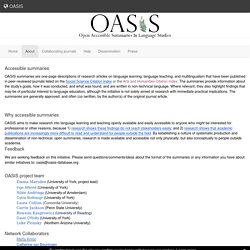
The summaries provide information about the study’s goals, how it was conducted, and what was found, and are written in non-technical language. Where relevant, they also highlight findings that may be of particular interest to language educators, although the initiative is not solely aimed at research with immediate practical implications. The summaries are generally approved, and often (co-)written, by the author(s) of the original journal article. 10 Rules for Internet Life - Digital Student - LibGuides at University of Hull. When you post anything online, write an email or share a post it will take other people's time to read.
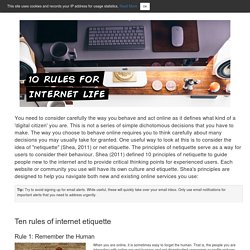
Shea (2011) argues "it's your responsibility to ensure that the time they spend reading your posting isn't wasted". It is important that you direct messages to the right people. With modern technology, it is too easy to send a message to everybody in your contact list. Instead, you need to spend time focusing your message and sending it to the relevant people.
Social networks can help you achieve that by focusing your contributions towards appropriate networks. When considering data limits - or bandwidth (the information-carrying capacity of the network), it is important to acknowledge storage and network speed limitations. Using texts. The Language Teacher Toolkit by Steve Smith and Gianfranco Conti is now available from Amazon.
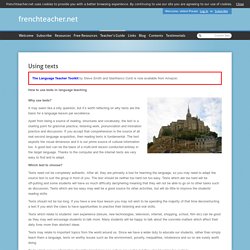
How to use texts in language teaching Why use texts? It may seem like a silly question, but it’s worth reflecting on why texts are the basis for a language lesson par excellence. Back to the Drawing Board? Logan Fiorella is an Assistant Professor of Educational Psychology at the University of Georgia.
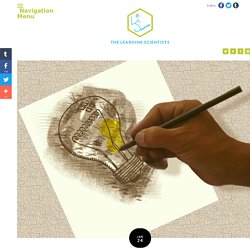
He is interested in how to help students apply what they have learned to new situations. His current research focuses on generative learning strategies, learning from examples, and the design of multimedia lessons. He is co-author (with Richard Mayer) of the recent book, Learning as a Generative Activity, which reviews the research evidence for eight strategies that promote meaningful learning. Learning Space Rating System. The Learning Space Rating System (LSRS) project provides a set of measurable criteria to assess how well the design of classrooms support and enable active learning.
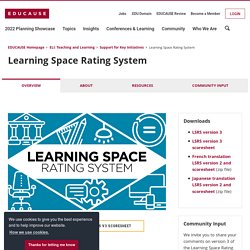
Noting the success of several architectural programs to promote sustainable building design, the LSRS provides a scoring system to serve as an indicator of how well a classroom's design serves the goal of active learning. The LSRS credits form the basis for a rating system that will allow institutions to benchmark their environments against best practices within the higher education community. The LSRS measures formal learning spaces, defined as classrooms typically scheduled centrally and designed to accommodate all course participants for synchronous meetings.
The Impact of Authentic Materials and Tasks on Students’ Communicative Competence at a Colombian Language School. Teaching excellence? Let’s hear it for good education. Skills Give You Talking Points…Proficiency Gives You A Goal… It’s been a quick start to the year.
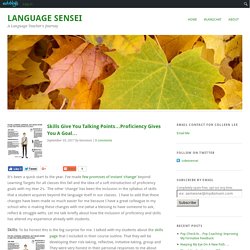
I’ve made few promises of instant ‘change’ beyond Learning Targets for all classes this fall and the idea of a soft introduction of proficiency goals with my Year 2’s. The other ‘change’ has been the inclusion in the syllabus of skills that a student acquires beyond the language itself in our classes. Conducting a privilege walk. This "privilege walk" exercise helps participants develop awareness of themselves, which can improve how they relate to others.
In this way, it invites people to think about ways inclusivity can create positive changes in their organizations. Facilitation steps Step 1. Explain to the group that we all have certain privileges others have not had. WG Education Report2017. Does elearning work full research report final. By putting forth this Manifesto, Michael Allen, Julie Dirksen, Clark Quinn, and Will Thalheimer invite all learning professionals to pledge to do the things that are necessary to create an engaging and effective experience fo.
Open Access Dokumente / Fremdsprachenunterricht 2.0. Making healthy skepticism happen in teaching and learning. In my research, I study the literacy practices of individuals in online and hybrid spaces.
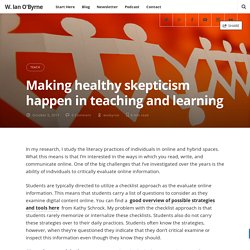
What this means is that I’m interested in the ways in which you read, write, and communicate online. One of the big challenges that I’ve investigated over the years is the ability of individuals to critically evaluate online information. Students are typically directed to utilize a checklist approach as the evaluate online information. This means that students carry a list of questions to consider as they examine digital content online. You can find a good overview of possible strategies and tools here from Kathy Schrock. What is PBL? To help teachers do PBL well, we created a comprehensive, research-based model for PBL — a "gold standard" to help teachers, schools, and organizations to measure, calibrate, and improve their practice.
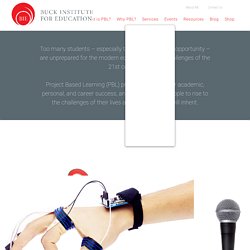
In Gold Standard PBL, projects are focused on student learning goals and include Essential Project Design Elements: Teachers – be careful on Twitter! – ICTEvangelist. Ok, so please excuse the sensationalist title.
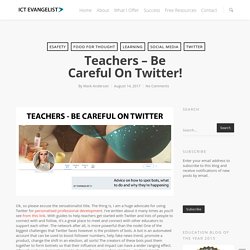
The thing is, I am a huge advocate for using Twitter for personalised professional development. I’ve written about it many times as you’ll see from this link. With guides to help teachers get started with Twitter and lists of people to connect with and follow, it’s a great place to meet and connect with other educators to support each other. The network after all, is more powerful than the node! One of the biggest challenges that Twitter faces however is the problem of bots. Evidence-based practice: The definition and explanation of. Good work: the Taylor review of modern working practices. #15toptips for Student-Centred Teaching 8: Time is precious, so try to avoid ‘re-inventing the wheel’ by reading about learning and teaching and learning from your colleagues.
Sometimes it’s worth reflecting on how many of our colleagues ended up involved in this rather strange world of higher education teaching, since teaching may not, in reality, have been the thing that motivated many to work in the sector. Some of us may have started out very much focused on our research, and have had teaching commitments foisted upon us. Some may have become involved in teaching whilst we were post-graduate research students. This was certainly how I first started teaching – I needed the money and an opportunity to do some teaching part-time on adult education courses provided a good ‘fit’ with my study commitments.
Some of our colleagues have entered higher education from practice in professional, public sector or commercial (private) business settings. Teaching and Learning Research Summaries: A collection for easy access. There are several superb summaries of educational research that have been compiled into easily accessible websites and articles in pdf format that can be read online and shared with staff. Although they are easy to find via an internet search, I am pulling them together into one place for easy access. I’ll keep adding to it as I find things and when people make suggestions: John Dunlosky: Strengthening the Student Toolbox. Knowing what they know. The thing I wish every teacher knew about technology is... Authors-discuss-new-book-effective-use-eportfolios#.WKLqBe20Az0.
About half of all colleges report some use of ePortfolios, in which students create a digital archive that tracks their learning progress and demonstrates knowledge and skills gained in college. But are colleges and their students all engaged in best practices? Probably not, suggests a new book, High-Impact ePortfolio Practice: A Catalyst for Student, Faculty, and Institutional Learning (Stylus). The authors are two educators at community colleges of the City University of New York: Bret Eynon, associate provost of LaGuardia Community College (a pioneer in ePortfolios) and Laura M.
Gambino, associate dean for assessment and technology Guttman Community College. Via email, they answered questions about their new book. Q: ePortfolios aren't new. A: There’s a lot that’s new. ePortfolio technology is becoming more fluid, supporting creative design and visual storytelling. Q: You both work at community colleges. A: The two word answer is “professional development.” E-Learning Development Team. Get started | Index | How to use Introduction The York Technology-Enhanced Learning (TEL) Handbook acts as a companion to your teaching practice, presenting approaches that are designed to improve student engagement and learning and teaching.
In the York TEL Handbook Recommended approaches to using the Yorkshare Virtual Learning Environment (VLE) to support campus-based courses and the York Pedagogy.Good practice check lists for content creation, site design, online activities, assessment and feedback.An evaluative and developmental approach to your use of Technology-Enhanced Learning. 6 Steps to Transition to Digital - Teacher Tech. 10 Simple Ways to Promote Staff Collaboration in your School - Eoin Lenihan Education. What’s the dif? Personalization, differentiation, individualization SmartBlogs. During a recent parent-teacher conference for my fourth-grader, the teacher said she had been differentiating instruction for my child. Language teachers and research – Of growth seekers and I-know-best autocrats. Framing digital capabilities for staff – deliverables. Collaborative-multiauthors-multiculture Education. When WE use Social-Media, especially Twitter, lots of users know already about a PLN (Personal [Professional] LEARNing Network) and through it WE get a MASS of information on a daily base.
Flipping the flipped classroom. For a while now, the paradigm of ‘flipping’ the classroom and reversing the way teachers and lecturers traditionally approach developing students knowledge has been gaining quite a lot of credence in educational circles. Copyright & Attribution – a mistake = lesson learned! Straight to the point …. Statistician explores how faculty can excel in blended learning environments. E-Learning Development Team. Reading List: Using Social Media for Research Collaboration and Public Engagement. Global Connections: Powerful PD with Craig Kemp – PTE011. Key Issues in Language Teaching #1: influences on curriculum design. Professor Jack Richards joins us this week for an exciting webinar on teaching beyond the classroom – sign up here! – and over the next five days, we’ll be sharing a short series of extracts from his new book.
Getting Technology Right in Schools – A Word with José Picardo. 6 Excellent YouTube Channels Created by Inspired Teachers. How to Connect With Other Teachers in the Social Age. What’s the point of education if Google can tell us anything? #nextpractice Webinars - ULD. HEROES & VILLAINS: AN ACADEMIC HONESTY AND INTEGRITY WEBSITE. Five reasons why you should 'do digital' Innovation in Action - Overview. Breaking down digital. Why lesson observation should be aimed at learning and not teaching. Alternative Formats. Twitter Chats. 5 Reasons why educators should embrace autonomy in schools. Instead of an AUP, how about an EUP (Empowered Use Policy)?
Jisc TechDis. A student’s lecture to professors. Teaching languages with technology: tools that help students become fluent. Peer Observation of Teaching. Welcome to ds106. Technology in education: if students aren't worried, why are teachers? Classroom practice - Teach students to set themselves free - news. Professor samr model e learning. Don’t want to imagine a teaching world without Twitter. Plus de 50h de vidéo sur les usages du numérique dans l’éducation.
Effective Practice in the use of ELT @ DMU. Effective Practice in the use of ELT @ DMU.